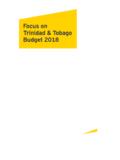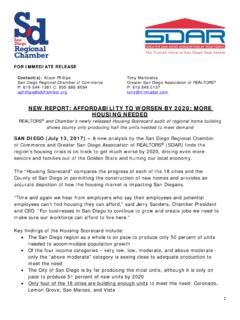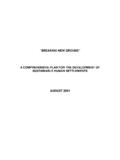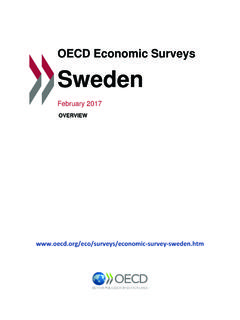Transcription of ISRAEL* - OECD.org
1 3. DEVELOPMENTS IN INDIVIDUAL OECD AND SELECTED NON-MEMBER ECONOMIESOECD ECONOMIC OUTLOOK, VOLUME 2018 ISSUE1 PRELIMINARY VERSION OECD 2018169 ISRAEL* Growth is projected to strengthen to over 3 per cent in 2018 and 2019. Supportfrom fiscal easing, very low interest rates and a stronger external environment will boostdemand and employment. In a tight labour market, rising wage pressures are projectedto lead to a steady increase in monetary authorities must stand ready to gradually raise interest rates onceinflation is sustainably back in the 1-3% targeted range.
2 Higher social spending andexpenditure on education and health care are welcome to foster more inclusive financing of these expenses with sufficient revenues would preserve budgetaryroom for manoeuvre and lower the risk of overheating. Reducing the existing large socialdisparities will be beneficial for growth, but will also requires intensifying structuralreforms that improve the skills and productivity of disadvantaged remains vigorousGDP growth accelerated to around 4 per cent year-on-year in the last quarter of 2017and first quarter of 2018.
3 Despite a decline in residential investment, activity remainedsolid at the beginning of 2018, with strong public consumption and good exportperformance, particularly of services. Although partly offset by imports, householdspending and business investment were exceptionally vigorous due to a sharp rise in carsales in advance of a programmed change in vehicle taxation in January 2019. Theunemployment rate fell to , and the vacancy rate is rising in most sectors, fuellingwage pressures. Prices edged up year-on-year in April 2018, but inflation remains low* The statistical data for Israel are supplied by and under the responsibility of the relevant Israeliauthorities.
4 The use of such data by the OECD is without prejudice to the status of the GolanHeights, East Jerusalem and Israeli settlements in the West Bank under the terms of Deflated by the private consumption :Bank of Israel; and OECD Economic Outlook 103 2 101234567024620102012201420162018Y o y % changes Real GDPS tate of the economy indexConsumer price indexGrowth is robust, but inflation remains very low0246810 20246820102012201420162018% of labour force Y o y % changes Unemployment rate Real compensation per employee Labour market pressures are rising3.
5 DEVELOPMENTS IN INDIVIDUAL OECD AND SELECTED NON-MEMBER ECONOMIESOECD ECONOMIC OUTLOOK, VOLUME 2018 ISSUE1 PRELIMINARY VERSION OECD 2018170due to reductions in public-sector tariffs and various measures stimulating importcompetition, including cuts in customs fiscal policy must be maintained while promoting more inclusive growthThe Bank of Israel has kept its policy rate at since March shekel stoppedappreciating in early 2018 and has stabilised in nominal effective terms around its average2017 level. Despite these still accommodative monetary conditions, demand for housinghas declined due in part to higher taxation of residential investment.
6 This has resulted ina stabilisation in property prices in early 2018, as against an increase by a year before,a trend which is likely to continue if monetary stimulus is withdrawn, as a budget deficit target set at of GDP in 2018 and 2019, up from an outcomeof of GDP in 2017, fiscal policy will support fiscal loosening, which resultsfrom increased spending in the social, education and health spheres, could be even morepronounced if new tax cuts mooted by the authorities are introduced. Yet, Israel mustpreserve ample fiscal margins, given heightened regional geopolitical tensions, and avoidpro-cyclical injections of extra spending power, which weaken its public accounts, whilethe economy is at full employment.
7 In such an environment, reforms that improve thetraining of disadvantaged groups, especially in the Israeli-Arab and Ultra-Orthodoxcommunities, the functioning of product markets and public transport infrastructureshould be favoured to strengthen both supply conditions and social :Demand, output and prices1 2 pricesNIS billionGDP at market prices1 Private consumption Government consumption Gross fixed capital formation Final domestic demand1 Stockbuilding1 Total domestic demand1 Exports of goods and services Imports of goods and services Net exports1
8 Memorandum itemsGDP deflator Consumer price index Core inflation index2 Unemployment rate (% of labour force) General government financial balance3 (% of GDP) General government gross debt (% of GDP) Current account balance (% of GDP) 1. Contributions to changes in real GDP, actual amount in the first column. 2. Consumer price index excluding food and energy.
9 3. Excluding Bank of Israel profits and the implicit costs of CPI-indexed government bonds. Source: OECD Economic Outlook 103 database. Percentage changes, volume (2015 prices)3. DEVELOPMENTS IN INDIVIDUAL OECD AND SELECTED NON-MEMBER ECONOMIESOECD ECONOMIC OUTLOOK, VOLUME 2018 ISSUE1 PRELIMINARY VERSION OECD 2018171 Growth should strengthenWith a favourable external context and expansionary macroeconomic policies, growthis projected to accelerate to over 3 per cent in 2018 and 2019. Low unemployment willcontinue to spur wages and household consumption.
10 In addition, capital spending will beunderpinned by planned investments in the high-tech sector and the development of newoffshore gas fields in 2019. Due to higher wage increases, inflation is expected to reach 1 per cent by the end of 2019. A deterioration of the already tense geopolitical situation or theexternal environment would, however, weaken these projections. Conversely, the economycould be stronger, and even overheat, if demand, supported by a better-than-expectedglobal environment, is more robust and the central bank is slow to withdraw stimulus orthe government follows through with tax cuts.


















